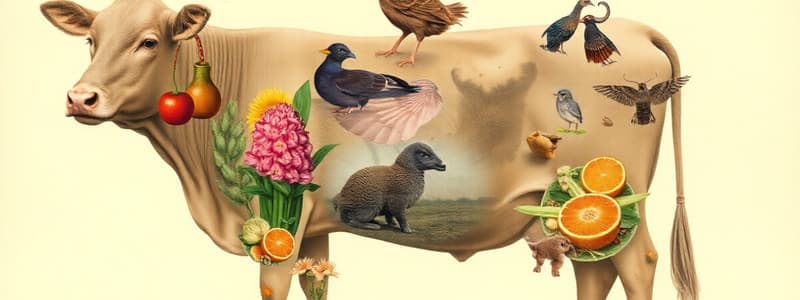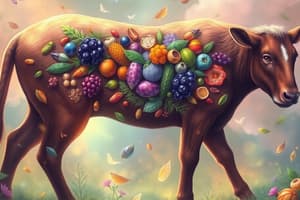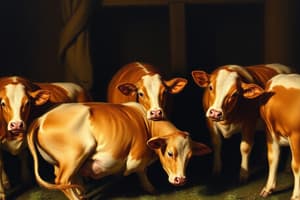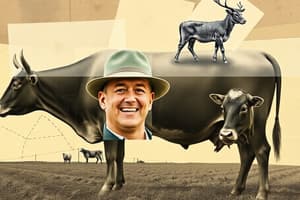Podcast
Questions and Answers
The science and practice of feeding animals, including how they ingest, digest, absorb, and use nutrients for various life processes is called ______.
The science and practice of feeding animals, including how they ingest, digest, absorb, and use nutrients for various life processes is called ______.
nutrition
Providing proper animal nutrition leads to good health, increased productivity, improved feed efficiency, and overall ______.
Providing proper animal nutrition leads to good health, increased productivity, improved feed efficiency, and overall ______.
well-being
A ______ is a substance that is necessary for an organism to live and grow, provided through feed and water.
A ______ is a substance that is necessary for an organism to live and grow, provided through feed and water.
nutrient
Farm animals primarily obtain their nutrients from plants, plant products, and by-products, as well as from ______ such as bone meal and fish meal.
Farm animals primarily obtain their nutrients from plants, plant products, and by-products, as well as from ______ such as bone meal and fish meal.
The six essential nutrients animals need are water, carbohydrates, fats, proteins, minerals and ______.
The six essential nutrients animals need are water, carbohydrates, fats, proteins, minerals and ______.
Water, making up 50-75% of an animal’s body weight, is crucial for transporting nutrients, aiding digestion, removing wastes, maintaining body temperature, and supporting ______.
Water, making up 50-75% of an animal’s body weight, is crucial for transporting nutrients, aiding digestion, removing wastes, maintaining body temperature, and supporting ______.
______, comprising at least 75% of an animal’s diet, provide energy necessary for metabolic activity, physical work, and the production of meat, eggs, and milk.
______, comprising at least 75% of an animal’s diet, provide energy necessary for metabolic activity, physical work, and the production of meat, eggs, and milk.
Energy deficiency, often caused by inadequate carbohydrates due to overgrazing, drought, or poor feed quality, is a common nutritional issue that limits the ______ of grazing animals.
Energy deficiency, often caused by inadequate carbohydrates due to overgrazing, drought, or poor feed quality, is a common nutritional issue that limits the ______ of grazing animals.
Grains such as ______, rice, and sorghum can be used as animal feed.
Grains such as ______, rice, and sorghum can be used as animal feed.
[Blank] are often provided to livestock to supplement their mineral intake, especially sodium.
[Blank] are often provided to livestock to supplement their mineral intake, especially sodium.
According to Lawes and Gilbert's analysis, the levels of water and ______ in an animal's body are inversely related.
According to Lawes and Gilbert's analysis, the levels of water and ______ in an animal's body are inversely related.
In a fat-free body, water, protein, and ash are found in the approximate ratio of 19:5:1, indicating that ______ is the most abundant component.
In a fat-free body, water, protein, and ash are found in the approximate ratio of 19:5:1, indicating that ______ is the most abundant component.
The ______ content in an animal's body varies and decreases as the animal ages.
The ______ content in an animal's body varies and decreases as the animal ages.
[Blank], along with some inorganic elements, is responsible for the structure of an animal’s body.
[Blank], along with some inorganic elements, is responsible for the structure of an animal’s body.
[Blank] is the most variable component of an animal's body composition.
[Blank] is the most variable component of an animal's body composition.
Calcium and ______ are the minerals that occur in the largest amounts in the body.
Calcium and ______ are the minerals that occur in the largest amounts in the body.
Energy deficiencies in animals can result in prolonged periods of ______ which markedly affects breeding cycles.
Energy deficiencies in animals can result in prolonged periods of ______ which markedly affects breeding cycles.
Proteins are organic compounds made up of ______ acids which contain carbon, hydrogen, oxygen, and nitrogen.
Proteins are organic compounds made up of ______ acids which contain carbon, hydrogen, oxygen, and nitrogen.
Besides plants, animal products such as fish meal, bone meal, and ______ meal serve as sources of protein in animal diets.
Besides plants, animal products such as fish meal, bone meal, and ______ meal serve as sources of protein in animal diets.
Fats have ______ times more energy than carbohydrates and are used to supply and store energy in animals.
Fats have ______ times more energy than carbohydrates and are used to supply and store energy in animals.
Excess energy from carbohydrates is stored as ______ under the skin, within muscle tissues and under the abdominal cavity.
Excess energy from carbohydrates is stored as ______ under the skin, within muscle tissues and under the abdominal cavity.
Vitamins are organic compounds required in small quantities for healthy growth and development, and are grouped into fat-soluble and ______-soluble types.
Vitamins are organic compounds required in small quantities for healthy growth and development, and are grouped into fat-soluble and ______-soluble types.
Vitamins are essential for the proper utilization of proteins, fats, and carbohydrates, as well as for processes like blood ______.
Vitamins are essential for the proper utilization of proteins, fats, and carbohydrates, as well as for processes like blood ______.
Deficiencies in vitamins can lead to symptoms such as retarded growth, poor reproduction, and ______ ailments in animals.
Deficiencies in vitamins can lead to symptoms such as retarded growth, poor reproduction, and ______ ailments in animals.
[Blank] promote healthy growth and development and are divided into macro & micro based off how much the animals need.
[Blank] promote healthy growth and development and are divided into macro & micro based off how much the animals need.
[Blank] and phosphorus are essential minerals for strong teeth and bones and prevent milk fever in dairy cattle.
[Blank] and phosphorus are essential minerals for strong teeth and bones and prevent milk fever in dairy cattle.
Flashcards
Animal Nutrition
Animal Nutrition
The science and practice of feeding animals, including how they ingest, digest, absorb, and use nutrients.
Benefits of Proper Nutrition
Benefits of Proper Nutrition
Good health, increased productivity, better feed efficiency, and overall well-being.
Nutrient
Nutrient
A substance necessary for an organism to live and grow, obtained through feed and water.
Main Nutrient Sources
Main Nutrient Sources
Signup and view all the flashcards
Six Essential Nutrients
Six Essential Nutrients
Signup and view all the flashcards
Functions of Water
Functions of Water
Signup and view all the flashcards
Carbohydrates
Carbohydrates
Signup and view all the flashcards
Types and Sources of Carbs
Types and Sources of Carbs
Signup and view all the flashcards
Common Animal Feed Grains
Common Animal Feed Grains
Signup and view all the flashcards
Mineral Licks
Mineral Licks
Signup and view all the flashcards
Fish Meal & Bone Meal
Fish Meal & Bone Meal
Signup and view all the flashcards
Animal Body Composition
Animal Body Composition
Signup and view all the flashcards
Water & Fat Relationship
Water & Fat Relationship
Signup and view all the flashcards
Protein in Animal Body
Protein in Animal Body
Signup and view all the flashcards
Fat in Animal Body
Fat in Animal Body
Signup and view all the flashcards
Major Minerals in Animal Body
Major Minerals in Animal Body
Signup and view all the flashcards
Energy Deficiency Effects
Energy Deficiency Effects
Signup and view all the flashcards
Proteins
Proteins
Signup and view all the flashcards
Sources of Protein
Sources of Protein
Signup and view all the flashcards
Protein Deficiency Effects
Protein Deficiency Effects
Signup and view all the flashcards
Fats & Lipids
Fats & Lipids
Signup and view all the flashcards
Vitamins
Vitamins
Signup and view all the flashcards
Vitamin Groups
Vitamin Groups
Signup and view all the flashcards
Vitamin Deficiency Effects
Vitamin Deficiency Effects
Signup and view all the flashcards
Minerals
Minerals
Signup and view all the flashcards
Sources of Minerals
Sources of Minerals
Signup and view all the flashcards
Study Notes
- Animal Nutrition & Feeding
Nutrition
- Nutrition is a branch of biology and the science and practice of feeding animals.
- Nutrition is the process by which animals ingest, digest, absorb, and use nutrients in feed for maintenance, growth, work, and reproduction.
- Proper animal nutrition means good health, increased productivity and feed efficiency, and well-being.
Nutrients Defined
- A nutrient is a substance necessary for an organism to live and grow.
- Nutrients enable animals to carry out life processes.
- Animals obtain nutrients through feed and water.
Sources of Nutrients for Farm Animals
- Plants, such as grasses, forage crops, and legumes, provide nutrients.
- Plant products and by-products, including grains like corn, rice, and wheat, as well as rice bran, wheat middlings, copra meal, and soybean meal, serve as nutrient sources.
- Animal products such as bone meal, fish meal, meat meal, shrimp meal, and milk provide nutrients
Essential Nutrients for Animals
- The six essential nutrients are water, carbohydrates, fats, proteins, minerals, and vitamins.
Water
- Water is essential for animal survival.
- Animals can survive longer without food than without water.
- Water is the largest component of nearly all living things.
- Water makes up 50-75% of an animal's body weight.
- Water transports nutrients, aids digestion, removes wastes, maintains body temperature, and is required for milk production.
Carbohydrates
- Carbohydrates are energy-producing nutrients with the formula C6H12O6 (glucose).
- Carbohydrates should comprise at least 75% of an animal's diet.
- Animals require energy supplied by carbs for metabolic activity, physical work, and production of meat, eggs, and milk.
Types and Sources of Carbohydrates
- Monosaccharides such as Glucose, Fructose, and Galactose are simple sugars.
- Disaccharides include Maltose, Sucrose, and Lactose.
- Polysaccharides include Starch, cellulose, hemi-cellulose, and lignin.
- Plants such as pasture grasses, plant products, and by-products like root crops, fruits, seeds, grains, rice bran, and wheat bran are all sources of carbohydrates
Energy Deficiency
- Energy deficiency, possibly a lack of carbohydrates, is the most common nutritional deficiency limiting grazing animal performance.
- Feed may lack adequancy due to overgrazing, drought, poor quality, digestibility, or cost; forage may have too much water, limiting energy intake.
- Energy deficiencies result in retarded growth in young animals, delayed puberty onset, shortened lactation, a decline in milk production, lost in body weight, prolonged anestrus periods, and weak or undersized offspring
Proteins
- Proteins are organic compounds made of amino acids that contain carbon, hydrogen, oxygen, and nitrogen.
- Animals require protein for building new cells and tissues, including muscles.
- Animals also require protein for the production of milk, wool, hairs, and feathers.
- Protein is needed for body maintenance, tissue repair and replacement, and the production of enzymes and hormones.
Sources of Protein
- Plants such as pasture legumes, field peas, and soybean plants provide protein
- Animal products like fish meal, bone meal, milk, meat meal, and blood meal are sources of protein.
Protein Deficiency
- Protein deficiency often comes with energy deficiencies.
- Protein deficiency symptoms include reduced appetite, lowered feed intake, lack of muscle development, prolonged time to reach maturity, loss of weight, and decreased milk production.
Fats and Lipids
- Lipids are made of fatty acids and glycerol, containing carbon, hydrogen, and oxygen.
- Fats provide 2.25 times more energy than carbohydrates.
- Fats supply and store energy where excess energy from carbs is stored as fat.
- Fat is stored under the skin, without the muscle tissues, and under the abdominal cavity.
- Sources of fats: oilseed meals (copra, canola, linseed), vegetable oils, tallow, and lard.
Vitamins
- Vitamins are organic compounds required in small quantities for healthy growth and development.
- Fat-soluble vitamins include Vitamins A, D, E, and K.
- Water-soluble vitamins include Vitamins B and C.
The Role of Vitamins
- Vitamins help use proteins, fats, and carbs.
- Vitamins enable blood clotting and bone formation.
- Vitamins assist in reproduction, lactation, prevent various nervous disorders.
- Vitamin deficiencies can cause retarded growth, poor reproduction, skin ailments, hemorrhaging, diarrhea, and night blindness
- VItamin deficiencies can also cause rough coat and muscular issues.
Sources of Vitamins
- Green pasture grasses, legumes, legume hays, silage, cereal grains, and oil seeds contain vitamins.
- Sunlight and injectable vitamin products are also sources for vitamins.
Minerals
- Minerals promote healthy growth and development.
- Sixteen essential minerals are divided into macro and micro minerals.
- Minerals have specific roles in an animal's body.
- Calcium and phosphorus help develop strong teeth and bones
- Minerals can help egg shell strength and act as a preventative agains milk fever in dairy cattle.
Sources of Minerals
- The sources are green pasture grasses, forages, legumes, cereal grains like corn, rice, and sorghum.
- Other sources include mineral licks (salt licks/blocks), fish meal, bone meal, and shrimp meal.
Composition of the Animal Body
- J.B. Lawes and J.H. Gilbert analyzed farm animals' bodies and shared their findings in 1859.
- The levels of water and fat vary inversely.
- The composition of a fat-free body includes Water: Protein: Ash = 19:5:1 (74-76%: 20-22%: 3-5%).
- In a fat and moisture-free body, the Protein: Ash ratio = 80:20.
- The body composition of a moisture-free and fat-free body is nearly constant.
Water Content
- The water content decreases as the animal ages,
- A cattle embryo has ~95% water, a newborn calf has ~75-80% water, a 5-month-old calf has ~66-72% water, and a mature animal has ~50-70% water.
- Blood plasma consist of 90-92% water, heart, kidneys, and lungs contain 80% water, muscles consist of 75% water, bones contain 45%, and teeth enamel has 5%.
- Water content depends on an animal's nutritional status.
Protein Content
- Protein and inorganic elements shape the animal's body structure.
- Protein is a major component of dry matter in muscles and other body organs.
- Muscles contain almost 75-80% protein.
- Protein is also present in hair, nails, feathers, hooves, skin, wool, tendons, and bones.
Fat Composition
- Fat content is the most variable body component.
- The fat content of an animal's body increases with age.
- Fat is usually located in adipose tissues under the skin, around the kidney, intestines, and other organs.
Carbohydrates Content
- Carbohydrates only make up approximately 1% of the total animal body.
- Carbohydrates constantly form and break down for various functions.
- They usually appear as glucose or glycogen in the muscles and liver.
Inorganic Elements
- Calcium and phosphorus occur in high amounts in the body, mainly in teeth and bones.
- Phosphorus is found with protein, fats, and other inorganic salts.
- Calcium and phosphorus make up 70% of body ash.
- Na, K, and Cl exist in fluids in inorganic form where other minerals construct tissues, fluids, and enzymes.
Studying That Suits You
Use AI to generate personalized quizzes and flashcards to suit your learning preferences.




